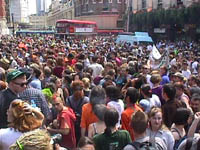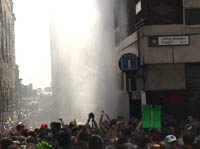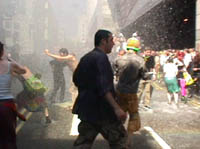June 18, 1999, known as J18, went down in history as a day of global protest against capitalism and corporate globalization. Inspired by previous actions and movements such as “Stop the City” in the 1980s, J18 became an international day of protest organized simultaneously in over 40 cities worldwide. One of the central events of this day was the “Carnival Against Capital” in London, which attracted thousands of activists and participants. This day marked a significant milestone in the history of anti-capitalist and anarchist movements, demonstrating the power of international solidarity and collective action.








Preparation and Organization
Preparation for J18 began long before the actual event. Inspired by the successes of previous anti-capitalist actions, activists from different countries united to plan coordinated protests around the world. The main organizer in London was the “Reclaim the Streets” (RTS) movement, which held monthly open meetings to discuss details and strategies for the upcoming action.
A key element of the preparation was an active campaign to inform and mobilize participants. In London, a spoof newspaper was created, colorful stickers and posters were distributed, and an 18-minute promotional video was produced and circulated. Leading up to J18, activists also organized benefit concerts to raise funds for the event.
The Day’s Events
In London, the protests began in the morning with participants of the “Critical Mass” bicycle ride blocking rush-hour traffic in the financial district. Simultaneously, autonomous actions and direct actions were directed against various financial institutions.
At noon, thousands of demonstrators gathered at Liverpool Street Station. Organizers divided the protesters into four marches, which were to converge at the London International Financial Futures and Options Exchange (LIFFE). This was done to confuse the police and increase the chances of a successful action.
When the marches converged at LIFFE, participants held a street party, chanted slogans, decorated walls with graffiti, and set up sound systems for DJs and punk bands to perform. Throughout the day, clashes occurred with the police, including the use of tear gas and mounted charges.
International Protests
Inspired by the events in London, J18 became a day of global protests held in more than 40 cities around the world, including Barcelona, Montevideo, Port Harcourt, and San Francisco. Activists from various movements, including labor, environmental, feminist, anti-capitalist, and anarchist groups, united to conduct coordinated actions against capitalism and globalization.
One of the unique features of J18 was the use of new technologies to coordinate and cover the protests. Independent media activists from London and Sydney used the internet to disseminate news about the protests, taking a step towards the creation of the Indymedia network.
Reaction and Aftermath
The reaction to J18 and the “Carnival Against Capital” was mixed. On one hand, the protests drew attention to issues of capitalism and corporate globalization, uniting thousands of people worldwide in the fight for justice and equality. On the other hand, direct actions and clashes with the police drew criticism from authorities and some media outlets.
The London police took strict precautions, canceling all leave for officers on June 18 and increasing security measures in the financial district. Despite this, the protesters managed to successfully conduct their actions and draw attention to their demands.
J18 became a significant milestone in the history of anti-capitalist movements, demonstrating the power of international solidarity and collective action. This day showed that activists could successfully coordinate their actions on a global level, using new technologies and organizational methods.
Conclusion
June 18, 1999, J18, became a day of global protest against capitalism and corporate globalization. Inspired by previous actions, the “Carnival Against Capital” in London and protests in other cities worldwide showcased the power of international solidarity and collective action. This day marked a significant milestone in the history of anti-capitalist movements, leaving a lasting impression on participants and observers alike.